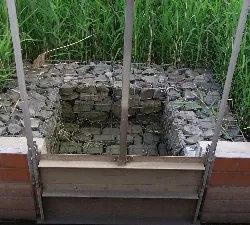- Determining the binding of heavy metals, biocides, and their transformation products with dissolved organic matter – Understanding pollutants interactions in building façade runoff. Ecotoxicology and Environmental Safety 291, 2025, 117887 more…
- Are infiltration swales all-rounders? An interdisciplinary field study on multifunctionality. Ecological Engineering 215, 2025, 107597 more…
- Decolourization properties of pure phases in hydrated cement paste for anionic dyes in textile wastewater. Heliyon 11 (4), 2025, e42231 more…
- Non-metal roofing materials as potential sources of pollutants- laboratory leaching studies on various roofing materials. Journal of Hazardous Materials 491, 2025, 137972 more…
- Surrogate-modelling of cyanotoxins adsorption pattern by pyrogenic carbonaceous materials. Journal of Molecular Liquids 423, 2025, 126996 more…
- Heavy metal leaching from stormwater control measures – insights into field and lab prestressed media and road-deposited sediments. Environmental Science: Water Research & Technology 11 (2), 2025, 328-340 more…
- Retention of Copper and Zinc from Traffic Area Runoff by Topsoil of Vegetated Infiltration Swales Amended with Recycled Demolition Waste. Sustainability 17 (3), 2025, 1048 more…
- Providing sufficient water for urban trees with limited root space during drought: Modeling of irrigation scenarios in a temperate climate. Urban Forestry & Urban Greening 104, 2025, 128670 more…
- An Interdisciplinary Criteria Catalog for Climate-Friendly Architectural Competitions - Test and Evaluation at Case Studies. In: Sustainable Cities. Springer Cham (1. edn.), 2025 more…
- Converting infiltration swales to sustainable urban drainage systems can improve water management and biodiversity. Frontiers in Environmental Science, 2025 more…
- Bezahlbar klimagerecht bauen – Kosten-Nutzen-Bewertung von Maßnahmen im Lebenszyklus. , Ed.: Bayerisches Staatsministerium für Umwelt und Verbraucherschutz (StMUV), 2024, more…
- Overview of the Mechanism of Degradation of Pharmaceuticals by Persulfate/Peroxysulfate Catalysts. ChemBioEng Reviews, 2024 more…
- Phytoextraction potential of herbaceous plant species and the influence of environmental factors – A meta-analytical approach. Ecological Engineering 199, 2024, 107169 more…
- Applications of perovskite oxides for the cleanup and mechanism of action of emerging contaminants/steroid hormones in water. Journal of Water Process Engineering 58, 2024, 104753 more…
- The potential of processed mineral construction and demolition waste to increase the water capacity of urban tree substrates - A pilot scale study in Munich. Sustainable Cities and Society 113, 2024, 105661 more…
- Influence of age, soil volume, and climate change on water availability at urban tree sites. Sustainable Cities and Society 113, 2024, 105680 more…
- Thriving under multiple stressors: Performance of drought-tolerant perennials and their suitability for infiltration swales. Urban Forestry & Urban Greening 101, 2024, 128535 more…
- Exploring the Potential of Amino-Functionalized Zeolite Series/H<sub>3</sub>PO<sub>4</sub>-Biochar for Environmental Microplastic Removal. Industrial & Engineering Chemistry Research 63 (9), 2024, 3947-3961 more…
- The Uptake Potential of Santa Barbara Amorphous Silica/Zeolite Composite for Environmental Microplastics in Wastewater. ACS ES&T Water 4 (12), 2024, 5447-5460 more…
- Perovskite Oxides: Syntheses and Perspectives on Their Application for Nitrate Reduction. ACS Omega 9 (18), 2024, 19770-19785 more…
This Research Group addresses questions on sewer systems and rainwater management. One focus of the group is the monitoring of contaminants in runoff from impervious surfaces. Another focus is the development and evaluation of decentralized treatment facilities for polluted runoff, often in close collaboration with companies.

The Research Group has a well-established track record in monitoring of heavy metals like copper and zinc from heavy metal roofs and road runoff. Beside legacy contaminants like heavy metals, organic pollutants like Methyl-tert-butylether or Ethyl-tert-butylether, which are widely used as anti-knocking agent, and biocides from building facades are of great research interest.In the field of managing sewer systems, one project worked on the estimation of costs for the construction of new and maintenance of existing sewer infrastructure which is of great interest.

